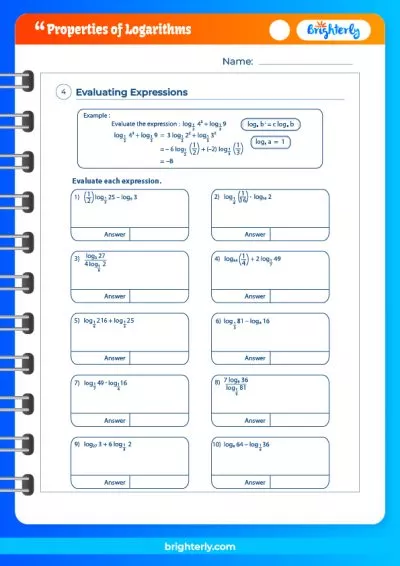Properties of Log – Definition With Examples
Created on Jan 01, 2024
Updated on January 14, 2024
Welcome to the Brighterly world of mathematics where we make learning an enjoyable and enlightening experience. As we delve into the journey of exploring and mastering numbers, it’s impossible to overlook the profound concept of logarithms. Logarithms, or “logs” as they’re colloquially known, are indeed an integral part of mathematics, shaping the structure of various scientific and real-world phenomena.
Understanding logarithms often serves as a gateway to unraveling complex mathematical problems and fostering a deeper understanding of the world. This blog post aims to shed light on the properties of logarithms, transforming them from daunting symbols on a page to a set of powerful tools in your mathematical toolbox.
From defining what logarithms are to exploring their significance, from unraveling their properties to diving into hands-on examples, this blog post covers it all. Whether you’re an ardent math enthusiast or a beginner stepping into the world of numbers, our post is designed to simplify the concept and offer a comprehensive understanding. So let’s start this exciting journey towards illuminating the properties of logarithms.
What Are Logarithms?
Logarithms, colloquially known as “logs,” are a fundamental aspect of mathematics and an important component in a variety of real-world applications. They’re a different way of thinking about exponentiation, providing an innovative solution to the problem of calculating complex numbers. In simple terms, the logarithm of a number is the exponent to which another fixed number, the base, must be raised to produce that number. For instance, the logarithm of 1000 to the base 10 is 3 because 10 to the power of 3 equals 1000.
This might seem daunting, but understanding logarithms can unlock a new world of mathematical comprehension. Children who master the concept of logarithms can find themselves with an arsenal of powerful problem-solving tools at their disposal, ready to tackle the mysteries of math.
Importance and Applications of Logarithms
Logarithms are more than just an intriguing mathematical concept; they have numerous practical applications. Logarithms form the core of many scientific calculations, including the measurement of the intensity of earthquakes (Richter scale), pH level calculation in chemistry, and in many complex calculations in physics and engineering.
Additionally, logarithms are a pivotal tool in the field of computer science. For example, they’re used in algorithms to reduce computational complexity, thus making the processing of large amounts of data faster and more efficient. In the world of finance, they come in handy for calculating compound interest, a key concept in economics.
Definition of Basic Logarithm
The concept of a logarithm is relatively simple once you break it down. If b^y = x, then the base b logarithm of x is equal to y. This is commonly written as log_b(x) = y. This relationship shows how logs and exponentials are simply two sides of the same mathematical coin. If we understand one, we can easily make sense of the other.
For instance, let’s take 10^2 = 100. Here, we can rewrite the equation in logarithmic form as log_10(100) = 2. This notation shows that the logarithm of 100 with base 10 is 2, which means that 10 must be raised to the power of 2 to obtain 100.
Definition of Properties of Logarithms
Just like any other mathematical function, logarithms come with their own set of properties that simplify their handling and computation. These properties offer a deep insight into the behavior of logarithms, providing tools for manipulating and simplifying logarithmic expressions.
The fundamental properties of logarithms are:
- Product Property:
log_b(M*N) = log_b(M) + log_b(N) - Quotient Property:
log_b(M/N) = log_b(M) - log_b(N) - Power Property:
log_b(M^n) = n*log_b(M)
Where b is the base, M and N are positive numbers, and n is any real number.
At Brighterly, we believe that practice is the key to mastery. That’s why we invite you to explore our properties of logarithms worksheets, where you can find an array of additional practice questions, complete with answers.
Overview of Logarithmic Properties
These properties of logarithms may initially seem complex, but they’re actually simple and intuitive when you break them down:
- Product Property: This property implies that the logarithm of a product of numbers is equivalent to the sum of their individual logarithms.
- Quotient Property: This property indicates that the logarithm of a quotient is equivalent to the logarithm of the numerator minus the logarithm of the denominator.
- Power Property: This property states that the logarithm of a number raised to an exponent is equivalent to the exponent times the logarithm of the number.
Detailed Explanation of Logarithmic Properties
Let’s take a deep dive into each property to better understand them:
- Product Property: Suppose you have two numbers, say 2 and 3, and you want to calculate the log of their product (i.e., 6) to the base 10. According to the product property,
log_10(2*3)is the same aslog_10(2) + log_10(3). - Quotient Property: If you have two numbers, say 8 and 2, the log of their quotient (i.e., 4) to the base 10,
log_10(8/2), equals the difference betweenlog_10(8)andlog_10(2). - Power Property: For any number, say 2 raised to the power of 3 (i.e., 8), the log to the base 10,
log_10(2^3), equals 3 timeslog_10(2).
Difference Between Various Properties of Logarithms
The fundamental difference between the properties of logarithms lies in the operations they represent – multiplication, division, and exponentiation. While the product and quotient properties are associated with addition and subtraction operations, the power property involves multiplication. These differences enable us to manipulate and simplify various logarithmic expressions effectively.
Expressions Involving Properties of Logarithms
Consider an expression like log_10(5^3 * 2/4). Using the properties of logarithms, we can simplify this expression. First, we use the product property, log_b(M*N) = log_b(M) + log_b(N), and the quotient property, log_b(M/N) = log_b(M) - log_b(N), to get log_10(5^3) + log_10(2) - log_10(4). Next, we apply the power property, log_b(M^n) = n*log_b(M), and we get 3*log_10(5) + log_10(2) - 2*log_10(2). Finally, we simplify it to get 3*log_10(5) - log_10(2).
Simplifying Expressions Using Logarithmic Properties
In the same vein, we can simplify complex expressions using these properties. Suppose we have an expression like 3*log_10(5) - log_10(2). This might look complicated at first, but by applying the properties of logarithms, we can break it down. The power property lets us rewrite 3*log_10(5) as log_10(5^3). Using the quotient property, we can write log_10(5^3) - log_10(2) as log_10((5^3)/2). Thus, 3*log_10(5) - log_10(2) simplifies to log_10(125/2).
Solving Equations Using Logarithmic Properties
Logarithmic properties can also be used to solve equations. Consider the equation log_2(x) + log_2(3) = 5. Using the product property, this can be simplified to log_2(3x) = 5. From this, we can infer that 3x = 2^5, hence x = 32/3.
Practice Problems on Properties of Logarithms
After understanding these logarithmic properties, it’s time to put your knowledge to the test. Here are a few problems that you can try to solve:
- Simplify
log_10(2*5^2). - Simplify
log_2((8*4)/2). - Solve for x in the equation
log_2(x^2) + log_2(4) = 3.
Remember, practice makes perfect. The more problems you solve, the better you will become at applying the properties of logarithms.
Conclusion
And with that, we’ve reached the end of our mathematical journey exploring the properties of logarithms. Logarithms, once daunting and enigmatic, should now feel like a familiar and empowering mathematical tool. The door to a myriad of complex calculations has been opened, ready for you to step through and embrace the next level of your mathematical journey.
At Brighterly, we believe in nurturing the curiosity of young minds and stoking the fires of learning. The exploration of logarithms is just one stop on this thrilling voyage of discovery. Remember, as you continue to explore and understand more advanced concepts, every challenge you face is a step towards becoming more proficient and confident in mathematics.
We hope that this article has added a brighter spark to your mathematical prowess. Just as logarithms transform complex multiplicative relationships into simpler additive ones, we aim to transform the often daunting world of mathematics into a more approachable and fascinating one. Keep practicing, stay curious, and continue to illuminate your mind, the Brighterly way.
Frequently Asked Questions on Properties of Logarithms
What exactly is a logarithm?
A logarithm is a way of expressing exponentiation in an inverse manner. Essentially, it tells you what power or exponent a certain base must be raised to, in order to get a specific number. If b^y = x, then the base b logarithm of x is equal to y. This is written as log_b(x) = y.
What are the properties of logarithms and why are they significant?
Logarithms come with their unique set of properties, which include the product property, the quotient property, and the power property. These properties are instrumental in simplifying complex logarithmic expressions, making them easier to compute and understand. They also provide a deep insight into the behavior of logarithms, and how they interact with various mathematical operations.
How are logarithms used in real-life situations?
Logarithms have a myriad of real-world applications. They are used in various fields of science, such as determining the intensity of earthquakes on the Richter scale, calculating the pH levels in chemistry, and in numerous complex computations in physics and engineering. Moreover, they play a crucial role in computer science algorithms, helping to reduce computational complexity, and in finance, they are key to calculating compound interest.






